Fishing Instinct ― 2018/05/05

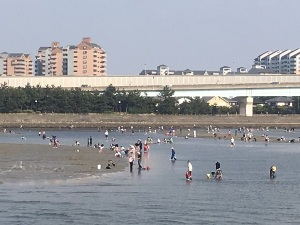
Austrian Style ― 2018/05/13
After a period of tough and Hikikomori days, I have finally had a lunch out after having a haircut!! What a wonderful day! Today’s lunch venue was an Austrian-style sport bar. I think I wrote about this spot before, but I only bought breads and cured meats without a luck to eat at the restaurant section.
Today’s lunch menu I chose was beans, pork and cabbage stew, small salad (carrot, potato and something I couldn’t distinguish), a table bread at 900 jpy.

The soup, salad and table bread were all nice.

Though at this point I felt I had already eaten as much as I usually have for lunch at home. It was just a beginning. Then came the main event.

The stew tasted nice, honestly! But the portion size was so generous that I felt the dish was intended for 18-year-old footballers, definitely not for an upper middle-aged woman(Obachan, to put it simple) losing her digestive ability. Actually, the stew felt like a bottomless swamp. I shovelled it into my mouth endless times but it was still there—almost intact. And the generous portion of fried potatoes… I skipped supper after having such a big meal.
Today’s
lesson: next time, I should ask if I can have a half-portion (or senior size)
or I should go for a lighter meal such as sandwiches or only a side dish if
possible. So I could enjoy one or two of the tempting-looking sweets with a cup
of European style coffee!
Three Generations of Futon Dryers ― 2018/05/18
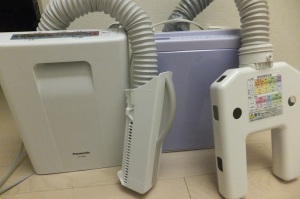
Maybe looking ridiculous or another unnecessary gadget to you, but futon dryers have become essential for our everyday life (at least in my household). It dries and warms (in winter) duvets and bed pads (and hopefully, the mattress underneath and is claimed to kill bed mites) every night so that we can enjoy dry and crisp (and hopefully hygienic and free from active mites—don’t imagine dead ones)sheet and duvet every night, which is one of the most decadent pleasures in this nation of humidity.
I guess futon dryers may not be a heavy duty machine, just like other modern electric appliances. Since we introduced it in 2012, we have three generations of futon dryer. Let me calculate…(2018-2012)/3=2…each machine lasts only two years in average…outrageously short-lived isn’t it? Born and raised in the 20th century in Japan, I tend to assume that once I buy an electric appliance, I would use it for my entire life. Is this idea no longer applicable in the 21st century?
Anyway, each of the successive machines has its characteristics. Here’s some notes on and memories about them.
The 1st Generation
A Panasonic with bag (for more detail, see my older post here).
The machine changed our sleeping ritual. We came to know how comfortable and sleep-inducing warm futon is in winter.
However, there was an issue with the nylon bag attached to the bag, which was to be set between the duvet and mattress and inflated with hot air to dry and warm the futons with the heat. After finishing its job, the bag would become electrified and give my hands electric shock, especially in colder seasons when the air and my hands become drier. So I had to ask my husband to remove the bag from the futon, which made me feel powerless and hopeless. Apart from this psychological burden, we happily used this until its sudden death: one day it just stopped working, however much we tried to resuscitate it by tapping its control panel or repeatedly turning on/off, it did not respond at all. Probably two-hour works every night was too much for it and its death should have been regarded as “Karoshi”.
The 2nd Generation: “The Beast”
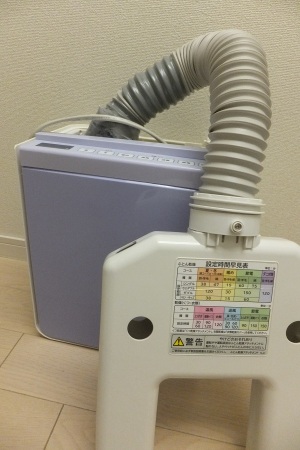
From here, our futon dryer became bagless. This machine dried futon with hot air blasted directly from the attached nozzle, just like a giant hair dryer. This machine’s power was remarkable. In fact, even in mid-winter, futon became too hot to get into immediately after the drying cycle finished. However, its tremendous power eventually damaged itself. The air tube was cracked several times though the motor was still working perfectly. After mended the tube with vinyl tape with no success,
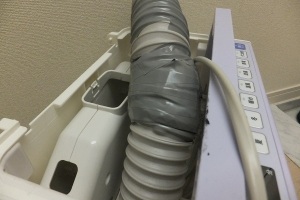
we gave up further repair. Hitachi, the manufacturer, also makes a variety of power stations, heavy machines and tanks as well as vacuum cleaners, toasters and other home appliance such as futon dryer. Am I wrong to connect the power of this machine with Hitachi’s “heavier” profile?
The 3rd Generation: “The Elegant”

In the beginning of this year, we replaced the self-harming Hitachi with a Panasonic, which behaves much more gently and elegantly. It softly blows warm air from its sleek nozzle and makes less noise than its predecessor. Compared to the one we bought in 2012, Panasonic seems to have made a significant progress in futon dryers. Actually, I initially doubt if it work as effective as its powerful predecessor. But it has turned out to be even better than the Hitachi. It dries futon efficiently enough so that I feel the futon even drier and puffier than before. As a person who feels it sinful to replace an electric appliance with another, I hope this will be my last futon dryer, in other words, it will live as long as myself.
Panasonic's Futon dryer page: https://panasonic.jp/tourist/en/futon/(I am not paid by the company, though) Have a good and dry sleep!
Bottled Cold Brew ― 2018/05/18

A newly released bottled coffee, 150 yen at a vending machine (possibly lower priced at discount stores or super markets).
Claimed to be cold brewed, it should taste richer and stronger than other canned black coffees. I’m not sure about the differences though. I just think I feel less metallic feeling from this new product.
I would place this somewhere between Nescafe and Doutor
coffee. The portion size seems a bit too much to finish during a short walk or
shinkansen ride, but perfect for a day supply at home or in hotel (where it can
be kept in fridge and served in glass, which could prevent contamination from direct
contact with the mouth).
My 10-year-old Bike and I and a Bicycle Shop (Text Only) ― 2018/05/21
My bike may be one of the oldest mamachari in my neighbourhood. It has reached 10 years old last year and still working with some parts replaced and the rust-covered frame. It’s just an industrially manufactured mamachari, but having oiled and polished it every 2 weeks, I have developed a certain affection for it.
The other day, the rear type became flat again, and I suddenly thought that it may be time to let it go and have a new one (mainly because my financial situation has been a bit better than it used to be for the past struggling 10 years, thanks to Abenomics). I went to a local, independent bike shop to have the tyre temporally fixed and get some information about (and possibly order) new models.
At the store, I was questioned why I needed a new bike when my old one was still ridable, and told me that the tyre needed an urgent replacement for safety reasons—yes, the surface of the tyre was slick and shiny, and I felt scared when riding on wet surfaces. I was instantly convinced by his opinion and immediately decided to ride it as long as possible (hoping my next means of transport to be motorised wheelchair called “senior car” here). So I ordered a tyre replacement, which costs around 4000 yen.
While working on my bike (other than the smooth tyre, my bike seemed to have problems I haven’t noticed) the shopkeeper/ repairer told me this and that about his trade and bike industry as a whole. Here’s notes from his lecture:
· Bikes displayed in bike shops are not rented from the manufacturer. The shop has to buy them at rather high costs;
· Selling big manufacturers’ new bikes is not particularly lucrative business for him. It feels much better to repair old bikes and be paid for his expertise;
· There is nothing wrong in buying a cheap bike (under 10,000 yen). The point is, whether you maintain it as same as you would do with more expensive one. Most of bike parts are replaceable so you can upgrade it according to your budget;
· Insuring your bike against theft is fine. But you could do more to avoid having your bike stolen—such as getting a good lock or parking the bike in designated and safer parking sites;
· Basically, bicycles’ longevity is unlimited. You could ride your bike unless the main frame is broken, which is very rare in properly made bikes. 10,000 yen per year is more than enough to keep your bike well maintained.
Now
that I got an approval from a professional, I will be with my good old
Panasonic for a few more years with confidence!
Sandal Hoarding ― 2018/05/21
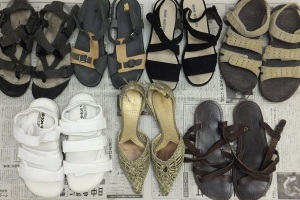
In order not to get athlete foot, I washed and dried my sandals before this year’s rainy season and summer as I recently found many shoes can be home-washed with hair shampoo (don’t try this at home).
When I pulled out all my sandals from the shoe cupboard, I was shocked to know that I have hoarded six pairs for the past 12 years (since I returned to Japan), and have just bought a new pair last week. Each pair did not cost much, but I could have got a pair or two of Hirofu or Repetto (at clearance sale) with the total amount of money I have spent on these.
I wonder why I bought so many footwear though I seldom go out during summer except for occasional evening walks and that I have only two feet in the first place. Did I think I was a centipede or something when I bought them?
Food Court with a View ― 2018/05/22

Today’s
snack was a doughnut and iced coffee (330 yen in total and the coffee was plenty!) at a local outlet mall
(with no shopping). But the real treat was this view, clear sky and fresh air!
Mobike Has Gone ― 2018/05/23
When a bike rental scheme called Mobike was introduced last year, it caused quite a buzz. We saw a lot of articles and tweets about the Chinese business. But now, the bike parking space occupied by the numerous rental bikes is abandoned. Absolutely no rental bike was there. They have all gone.

January this year
↓
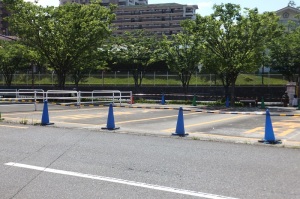
and Now
An interesting thing is, no one has spoken about the scheme’s demise, as if it had not existed in the first place. Mm, very Fukuoka. We have seen a number of projects debuted with fanfare, but soon abandoned and forgotten—just like the hydrogen station, the Kawaii Ward project or the subway line with a huge deficit.
By the way, I wonder where all the bikes have gone. Other test sites? Or second-hand market?
My
previous post about Mobike is here.
最近のコメント